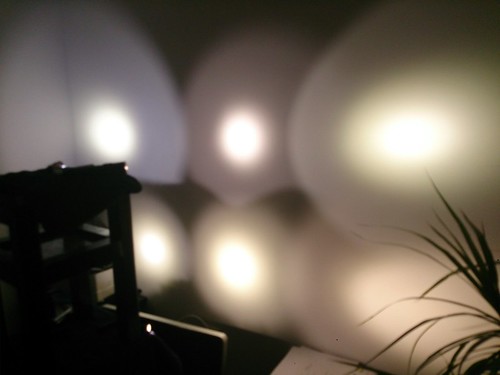I know there are many pitfalls in tint recording and reproduction but I'll ask the question anyway.
First a six-barrel white wall shot:

This is six flashlights with six different (all non cool-white  ) emitters, FYI:
) emitters, FYI:
top left XP-G2 3C top middle Nichia 219 top right XM-L2 5B1 80CRI
bottom left XM-L 4000K bottom middle XP-G2 ? bottom right XM-L2 6A1 80CRI
So you think you can look at this picture and have an actual idea of the tints? Very wrong!
First your and my monitor are not calibrated, so you see the tints in this picture a bit different than I do. But actually it is not so bad: my phone display (Sony, brand new), digital camera display (Sony, 4 years old) and Apple Mac monitor are not too far apart in how the tints are reproduced.
Second, who says that I perceive the tints the same as you do (the old thought-experiment that if I could look through your eyes I might perceive red as blue and blue as red, who knows: it is just what you are used to). But this is more theory than actually affecting my problem.
Third and this is the real bottleneck (and it is really annoying me): None of my digital camera's in none of the white balance settings -preset or custom adjusted- manages to actually registrate all tints correctly. When the photograph is displayed next to the original beams on the wall it is very different. One white balance setting that reproduces the Nichia quite correct (in the picture above that setting is used) gives too much blue in the 3C (the actual tint is more purple) and far too much yellow in the beam on the bottom middle. And another tint is correct the first one is horrible, etc. Most obvious is that you can not reproduce the blues correctly without getting too much yellow as well. In the above picture the Nichia (top middle) looks redder than the unknown tint (bottom middle) while that bottom one in real life has more red, but there is just so much yellow displayed that you don't see it. Etc., etc., etc.
I have not tried to correct the pictures with Photoshop but I suspect that that will not help because there is color information missing. It is just not registered by the camera in the first place (I guess the camera uses a quite different color determination system than our eyes).
Now to the question: my camera's are not remotely state-of-the-art professional camera's and I am not planning to buy one, but out of curiosity: does anyone of you know if there are there camera's around that can do this trick more correctly?
 .
. .
.